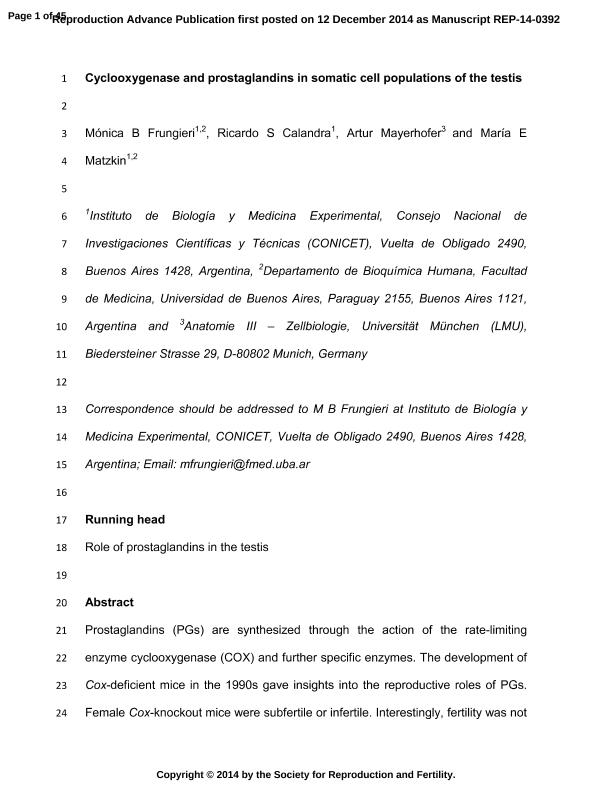Mostrar el registro sencillo del ítem
dc.contributor.author
Frungieri, Monica Beatriz

dc.contributor.author
Calandra, Ricardo Saul

dc.contributor.author
Mayerhofer, Artur
dc.contributor.author
Matzkin, Maria Eugenia

dc.date.available
2016-12-27T20:54:37Z
dc.date.issued
2015-04
dc.identifier.citation
Frungieri, Monica Beatriz; Calandra, Ricardo Saul; Mayerhofer, Artur; Matzkin, Maria Eugenia; Cyclooxygenase and prostaglandins in somatic cell populations of the testis; Bioscientifica; Reproduction; 149; 4; 4-2015; R169-R180
dc.identifier.issn
1470-1626
dc.identifier.uri
http://hdl.handle.net/11336/10349
dc.description.abstract
rostaglandins (PGs) are synthesized through the action of the rate-limiting enzyme cyclooxygenase (COX) and further specific enzymes. The development of Cox-deficient mice in the 1990s gave insights into the reproductive roles of PGs. Female Cox-knockout mice were subfertile or infertile. Interestingly, fertility was not affected in male mice deficient in Cox, suggesting that PGs may not be critical for the functioning of the testis. However, this conclusion has recently been challenged by observations of important roles for PGs in both physiological and pathological processes in the testis. The two key somatic cell types in the testis, Leydig and Sertoli cells, express the inducible isoenzyme COX2 and produce PGs. Testicular COX2 expression in these somatic cells is regulated by hormonal input (FSH, prolactin (PRL), and testosterone) as well as by IL1β. PGs modulate steroidogenesis in Leydig cells and glucose uptake in Sertoli cells. Hence, the COX2/PG system in Leydig and Sertoli cells acts as a local modulator of testicular activity, and consequently may regulate spermatogenic efficiency. In addition to its expression in Leydig and Sertoli cells, COX2 has been detected in the seminiferous tubule wall, and in testicular macrophages and mast cells of infertile patients. These observations highlight the possible relevance of PGs in testicular inflammation associated with idiopathic infertility. Collectively, these data indicate that the COX2/PG system plays crucial roles not only in testicular physiology (i.e., development, steroidogenesis, and spermatogenesis), but more importantly in the pathogenesis or maintenance of infertility status in the male gonad. Further studies of these actions could lead to new therapeutic approaches to idiopathic male infertility.
dc.format
application/pdf
dc.language.iso
eng
dc.publisher
Bioscientifica

dc.rights
info:eu-repo/semantics/openAccess
dc.rights.uri
https://creativecommons.org/licenses/by-nc-sa/2.5/ar/
dc.subject
Testis
dc.subject
Male Fertility
dc.subject
Photoperiod
dc.subject
Prostaglandin
dc.subject.classification
Bioquímica y Biología Molecular

dc.subject.classification
Medicina Básica

dc.subject.classification
CIENCIAS MÉDICAS Y DE LA SALUD

dc.title
Cyclooxygenase and prostaglandins in somatic cell populations of the testis
dc.type
info:eu-repo/semantics/article
dc.type
info:ar-repo/semantics/artículo
dc.type
info:eu-repo/semantics/publishedVersion
dc.date.updated
2016-10-04T19:25:07Z
dc.identifier.eissn
1741-7899
dc.journal.volume
149
dc.journal.number
4
dc.journal.pagination
R169-R180
dc.journal.pais
Reino Unido

dc.journal.ciudad
Cambridge
dc.description.fil
Fil: Frungieri, Monica Beatriz. Consejo Nacional de Investigaciones Científicas y Técnicas. Instituto de Biología y Medicina Experimental (i); Argentina. Universidad de Buenos Aires. Facultad de Medicina. Departamento de Bioquímica Humana; Argentina
dc.description.fil
Fil: Calandra, Ricardo Saul. Consejo Nacional de Investigaciones Científicas y Técnicas. Instituto de Biología y Medicina Experimental (i); Argentina
dc.description.fil
Fil: Mayerhofer, Artur. Zellbiologie Universität München; Alemania
dc.description.fil
Fil: Matzkin, Maria Eugenia. Consejo Nacional de Investigaciones Científicas y Técnicas. Instituto de Biología y Medicina Experimental (i); Argentina. Universidad de Buenos Aires. Facultad de Medicina. Departamento de Bioquímica Humana; Argentina
dc.journal.title
Reproduction

dc.relation.alternativeid
info:eu-repo/semantics/altIdentifier/url/http://www.reproduction-online.org/content/149/4/R169
dc.relation.alternativeid
info:eu-repo/semantics/altIdentifier/doi/http://dx.doi.org/10.1530/REP-14-0392
Archivos asociados
